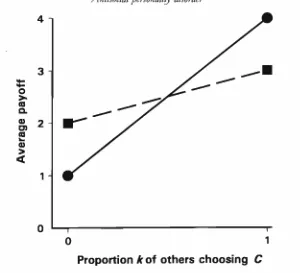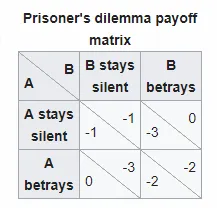In recent weeks, two phenomena have occupied my attention. Although these phenomena seem to be unrelated, I think there is a connection. The first phenomenon is the flood of celebrity sexual misconduct allegations that have permeated the news in the weeks since the NY Times' Harvey Weinstein exposé, and the second phenomenon is the abusive self and paid voting that happens here at steemit.
Unfortunately, I don't remember where, but some years ago, I read an article that asked a question that caught my attention, and which seems to link these two types of behavior. The question was something like this:
If human societies thrive when people cooperate and deteriorate under conflict, then after 100,000+ years of human evolution, why haven't anti-social behavioral traits been eliminated?
Today, I thought I'd do some reading to gain some insight into that question. In the following sections, I'll describe some of what I found. This is definitely not exhaustive coverage of the question, just what I've managed to pull together from a couple hours of web searches and reading. Topics that I'll cover in this essay will include a brief description of evolutionary psychology, descriptions of three models which have been used to study the question, namely the Chicken (the "Hawk-Dove" game), the Prisoner's Dilemma, and Ultimatum games, then I'll close with some thoughts of my own.

 Image Source: pixabay.com, License: CC0, Public Domain
Image Source: pixabay.com, License: CC0, Public Domain According to Stanford University's Encyclopedia of Philosophy, like much of cognitive science, evolutionary psychology is a field of study that approaches cognition as the study of internal psychological mechanisms. Evolutionary psychology's distinguishing characteristic, however, is the understanding that these mechanisms were adapted through successive applications of natural selection.
Cosmides and Tooby, at UC Santa Barbara's Center for Evolutionary Biology, provide the following principles of evolutionary psychology:
- Principle 1. The brain is a physical system. It functions as a computer. Its circuits are designed to generate behavior that is appropriate to your environmental circumstances.
- Principle 2. Our neural circuits were designed by natural selection to solve problems that our ancestors faced during our species' evolutionary history.
- Principle 3. Consciousness is just the tip of the iceberg; most of what goes on in your mind is hidden from you. As a result, your conscious experience can mislead you into thinking that our circuitry is simpler that (sic) it really is. Most problems that you experience as easy to solve are very difficult to solve -- they require very complicated neural circuitry
- Principle 4. Different neural circuits are specialized for solving different adaptive problems.
- Principle 5. Our modern skulls house a stone age mind.
They further claim that these principles can be used to gain an understanding of most aspects of human behavior, including: "sex and sexuality, how and why people cooperate, whether people are rational, how babies see the world, conformity, aggression, hearing, vision, sleeping, eating, hypnosis, schizophrenia and on and on." An interesting observation is that in this framework, our cognition is adapted to solve the problems of our ancestors, not necessarily our own problems.
Stanford's Encyclopedia of Philosophy further argues that evolutionary psychology views the human mind as, "massively modular." As I understand it, this implies that the mind is not viewed as a general purpose computer, but rather a massive collection of special purpose computers that have evolved to solve specific types of problems.
Evolutionary psychology and the broader subject areas of evolutionary biology and evolutionary game theory have been used to study questions of cooperation, competition, and aggression. One way to investigate these questions is through the use of models and simulations. Some of these will be described in the next section.

 Image Source: pixabay.com, License: Public Domain, CC0
Image Source: pixabay.com, License: Public Domain, CC0 I came across three articles that will inform this section of the essay. In a 1997 paper, Antisocial personality disorder: An evolutionary game theory analysis, Colman and Wilson described the Hawk-Dove game, commonly known as "Chicken", and used it to investigate anti-social personality disorder (APD). In his 2013 article, Evolution Does Not Reward Selfish and Mean People, Christopher Bergland summarized the findings from Evolutionary instability of zero-determinant strategies demonstrates that winning is not everything by Adami & Hintze. That Nature article, in turn, linked back to Iterated Prisoner’s Dilemma contains strategies thatdominate any evolutionary opponent, by Press & Dyson. Both of those articles discussed simulations using the Prisonner's Dilemma (PD), and Press & Dyson further noted that some instances of PD are equivalent to ultimatum games.
An interesting note is that Colman & Wilson specifically said that the prisonner's dilemma is not a suitable model for studying antisocial personality disorder. They list a number of reasons for this, but for this discussion, I'll mention two. First, the percentage of population with APD is known to be a stable percentage around 2%, but the prisonner's dilemma does not converge on that result. Second, the prisonner's dilemma does not adequately model the predatory nature of APD.
Instead, the authors propose the Hawk-Dove game, or Chicken, which is modelled after the well-known real world game of chicken where two players engage in a dangerous behavior, and the first one to yield loses. The game was illustrated in the tractor scene of the 1984 movie, Footloose. In this game, the scoring is described in the following diagram:

The game of Chicken is defined by the payout order:
The authors provide this diagram illustrating their results,

They find that the model converges to the place where the two lines intersect, which is close to the real world observation of 2%.
In this model, antisocial behavior becomes a strategic niche, where it is sensible for some players - but not too many - to develop antisocial tendencies. If this model represents reality, then Darwinian evolution would be on a perpetual self-correcting course to maintain the level of APD to the equilibrium point.
The articles by Adami & Hintze, and Press & Dyson study the prisoner's dilemma purely as a mathematical phenomenon. It's only in Bergland's summary that the findings get extended to people, so in light of Colman & Wilson's discussion of PD, that extension may be an overreach.
The prisoner's dilemma is a well-known two person game simulating a police investigation. In the scenario, two people are separated from one another and questioned. If the players both remain silent (known as cooperating), they earn the best score. If one implicates the other (known as defecting) while the other keeps silent, then both players are penalized, but the cooperator is penalized more than the defector. If both defect, both are penalized - more than the cooperator but less severely than the defector in the case of a split decision. Wikipedia illustrates the scoring like this:

Press & Dyson found that there is a class of strategies, known as zero-determinant strategies, where one player can unilaterally determine the other player's score and set up an extortion scheme where the second player's best interest lies with submitting to the extortion.
However, Adami & Hintze found that these strategies are not evolutionarily stable, so they would not be expected to survive through numerous generations.
An ultimatum game is a game in which one player dictates the split of the payout to all other players. As noted above, with the zero-determinate strategies from Press & Dyson, the Prisoner's dilemma game collapses into an ultimatum game.

Antisocial behavior can be found in many places, from crime to sexual misconduct to abusive behavior on steemit.
I'll never forget the first time I read about the prisoner's dilemma in Scientific American, sometime in the late eighties or early nineties. It was a truly amazing concept, and I assume that many other people have been similarly impressed by it, and it's tempting to try to apply it to all sorts of situations. However, for those of us who have not formally studied game theory, it is starting to seem like maybe there's a tendency to overfit it. (As they say, "When all you have is a hammer, every problem looks like a nail.")
The results form Adami & Hintze are mathematically elegant, but if - as claimed by Bergland - they describe a world where antisocial behavior is eliminated by evolution, then the mere fact that antisocial behavior continues to exist demonstrates that those equations don't describe our world. To be fair, it was Bergland's summary, not the primary papers that mapped those results from the domain of mathematics to the domain of human behavior, but I think the approach by Colman & Wilson is probably more useful for this particular question because they found a model that actually fits the observation.
Once they understood the nature of the model, they were also able to deduce some interesting possible social implications:
Circling back to the introduction, if this Hawk-Dove model describes real world human behavior, then it may explain why sexual misconduct continues to be a problem for generation after generation in human society, and why a small number of offenders have such a wide-ranging impact on a large number of victims. It may also explain why some people are driven to abusive voting behaviors on steemit, even when they know that it may have a long term negative value on their holdings.
On a positive note, it also tells us that both situations will find levels of equilibrium and that there are things we can do to lower the equilibrium level.
One final thought is that there may be a reason why the propensity for antisocial behavior is maintained. At the societal level, this type of behavior may have helped our ancestors' tribes in the competition for scarce resources, and it might be useful in modern society for defensive and offensive militaristic endeavors.
